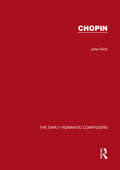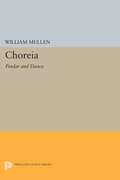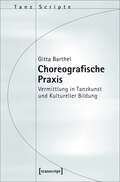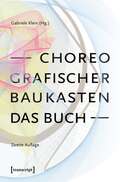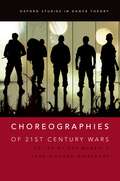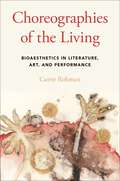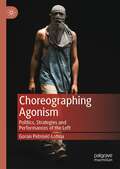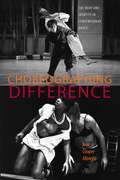- Table View
- List View
Choice Architecture: A new approach to behavior, design, and wellness
by Avani Parikh Prashant ParikhFrom Vitruvius in the 1st century BCE on, there has been an attempt to understand how architecture works, especially in its poetic aspect but also in its basic functions. Design can encourage us to walk, to experience community, to imagine new ways of being, and can affect countless other choices we make that shape our health and happiness. Using the ideas of rational choice theory and behavioral economics, Choice Architecture shows how behavior, design, and wellness are deeply interconnected. As active agents, we choose our responses to the architectural meanings we encounter based on our perception of our individual contexts. The book offers a way to approach the design of spaces for human flourishing and explains in rich detail how the potential of the built environment to influence our well-being can be realized.
A Choice Collection of Books on Painting and Graphic Arts Including a Number of Works on Illuminated Manuscripts and Portrait Miniatures: From the Stock of Martinus Nijhoff Bookseller
by Martinus NijhoffChoir Boy
by Tarell Alvin McCraneyThose melodies, the pitch harmonies andRhythms, those are the maps and guides to the PromisedLand. Not on this earth but elsewhere . . .Determined to make his mark like those before him, Pharus is hell-bent on being the best choir leader in the school's fifty-year history. First he must gain the respect of his peers, but he's an outsider in a world steeped in rites and rituals, a community that demands he conform.Tarell Alvin McCraney's piercing new play set in an all boys, all black American prep school scores a gospel refrain of the politics of minority and masculinity.Choir Boy premiered at the Theatre Upstairs at the Royal Court, London, in September 2012. It was commissioned by, and is a co-production with Manhattan Theatre Club and was supported by The Andrew W. Mellon Foundation.
The Chooky Brae
by D. C. JacksonIt's Christmas Day in Stewarton and Irene Gordon's struggling to get in the festive spirit. Her eighteen-year-old daughter has just had a baby, her ex-husband's had a stroke and her eldest is having a breakdown. Even the Dr Who special is disappointing. To compensate, she gets Rab McGuire, a gift-wrapped male sex aid and an escaped chicken that won't be stuffed.The final chapter of the Stewarton trilogy (The Wall and The Ducky), D. C. Jackson's The Chooky Brae premiered in a Borderline Theatre Company production at the Palace Theatre, Kilmarnock, in September 2010.
Choosing and Using a Refracting Telescope (The Patrick Moore Practical Astronomy Series)
by Neil EnglishChoosing and Using a Refracting Telescope has been written for the many amateur astronomers who already own, or are intending to purchase, a refracting telescope – perhaps to complement their existing arsenal of larger reflecting telescopes – or for the specialist who requires a particular refractor for serious astronomical applications or nature studies.Four hundred year ago, during the winter of 1609, a relatively unknown Italian scientist, Galileo Galilei designed a spyglass with two crude lenses and turned it skyward. Since then, refractors have retained their dominance over all types of reflector in studies of the Moon, planets and double stars because of the precision of their optics and lack of a central obstruction in the optical path, which causes diffraction effects in all commercially-made reflectors.Most mature amateur astronomers got started with a 60mm refractor, or something similar. Thirty years ago, there was little choice available to the hobbyist, but in the last decade long focus crown-flint achromats have moved aside for some exquisitely crafted apochromatic designs offered by leading commercial manufacturers. There has been a huge increase in the popularity of these telescopes in the last few years, led by a significant increase in the number of companies (particularly, William Optics, Orion USA, StellarVue, SkyWatcher and AstroTech) who are now heavily marketing refractors in the amateur astronomical magazines.In Choosing and Using a Refracting Telescope, well-known observer and astronomy writer Neil English celebrates the remarkable history and evolution of the refracting telescope and looks in detail at the instruments, their development and their use. A major feature of this book is the way it compares not only different classes of refractor, but also telescopes of each class that are sold by various commercial manufacturers. The author is perhaps uniquely placed to do this, having used and tested literally hundreds of different refracting telescopes over three decades.Because it includes many diverse subjects such as imaging with consumer-level digital cameras, imaging with webcams, and imaging with astronomical CCD cameras – that are not covered together in equal depth in any other single volume – Choosing and Using a Refracting Telescope could become the ‘refractor bible’ for amateur astronomers at all levels, especially those who are interested in imaging astronomical objects of every class.
Choosing and Using Fiction and Non-Fiction 3-11: A Comprehensive Guide for Teachers and Student Teachers
by Margaret MallettChoosing and Using Fiction and Non-Fiction 3-11 is a guide for primary teachers to the many kinds of texts children encounter, use and enjoy in their nursery and primary school years, providing an invaluable insight into the literature available. Addressing important issues and allowing for the voices of teachers, reviewers and children to be heard, it contains suggestions of best practice which offer a more creative approach to learning. Including both fiction and non-fiction, with genres ranging from picturebooks to biographies, this fully updated second edition features: New coverage on recent books Discussion of new changes in concepts of literacy, particularly focused on technological advances in moving image media and virtual worlds The balance between print and screen-based texts on developing children’s visual and multimodal literacy Annotated booklists for each genre for different age groups New sections on equality, diversity and translation Exploring fiction, non-fiction and poetry, Choosing and Using Fiction and Non-Fiction 3-11 is an invaluable resource, supporting teachers as they help children on their journey to becoming insightful and critical readers of non-fiction, and sensitive and reflective readers of fiction.
Chopin
by John RinkThis anthology brings together representative examples of the most significant and engaging scholarly writing on Chopin by a wide range of authors. The essays selected for the volume portray a rounded picture of Chopin as composer, pianist and teacher of his music, and of his overall achievement and legacy. Historical perspectives are offered on Chopin’s biography ’as cultural discourse’, on the evolution and origins of his style, and on the contexts of given works. A fascinating contemporary overview of Chopin’s oeuvre is also provided. Seven source studies assess the status and role of Chopin’s notational practices as well as some enigmatic sketch material. Essays in the field of performance studies scrutinise the ’cultural work’ carried out by Chopin’s performances and discuss his playing style along with that of his contemporaries and students. This paves the way for a body of essays on analysis, aesthetics and reception, considering aspects of genre and including an overview of analytical approaches to select works. The remaining essays address Chopin’s handling of form, rhythm and other musical elements, as well as the ’meaning’ of his msuic. The collection as a whole underscores one of the most important aspects of Chopin’s legacy, namely the paradoxical manner in which he drew from the past - in particular, certain eighteenth-century traditions - while stretching inherited conventions and practices to such an extent that a highly original ’music of the future’ was heralded.
Chopin
by John RinkThis anthology brings together representative examples of the most significant and engaging scholarly writing on Chopin by a wide range of authors. The essays selected for the volume portray a rounded picture of Chopin as composer, pianist and teacher of his music, and of his overall achievement and legacy. Historical perspectives are offered on Chopin’s biography ’as cultural discourse’, on the evolution and origins of his style, and on the contexts of given works. A fascinating contemporary overview of Chopin’s oeuvre is also provided. Seven source studies assess the status and role of Chopin’s notational practices as well as some enigmatic sketch material. Essays in the field of performance studies scrutinise the ’cultural work’ carried out by Chopin’s performances and discuss his playing style along with that of his contemporaries and students. This paves the way for a body of essays on analysis, aesthetics and reception, considering aspects of genre and including an overview of analytical approaches to select works. The remaining essays address Chopin’s handling of form, rhythm and other musical elements, as well as the ’meaning’ of his msuic. The collection as a whole underscores one of the most important aspects of Chopin’s legacy, namely the paradoxical manner in which he drew from the past - in particular, certain eighteenth-century traditions - while stretching inherited conventions and practices to such an extent that a highly original ’music of the future’ was heralded.
CHORA / Raoul Bunschoten: From Matter to Metaspace: Cave, Ground, Horizon, Wind (Consequence Book Series on Fresh Architecture #4)
by Raoul BunschotenDieses Buch zeichnet anhand von Situationen und Projekten unterschiedlichsten Maßstabs die Entwicklung eines architektonischen Programms von der ersten zur zweiten ‚Haut‘ nach und ist in 4 Cluster gruppiert: Höhle, Land, Horizont und Wind. Ein begleitender Text verbindet die einzelnen Projekte mit programmatischen und poetischen Konzepten. CHORA research wurde 1994 von Raoul Bunschoten gegründet und ist mittlerweile um CHORA architecture and urbanism sowie CHORA NL erweitert worden. Die Projekte, die von diesen drei Organisationen durchgeführt werden, umfassen intuitive Materialforschung, hauptsächlich Beton in seinen unterschiedlichsten Formen, Untersuchungen zu operationalen ‚Metaspaces‘ für Stadtplanung und Entscheidungsfindung, den Auftrag zur Entwicklung eines dynamischen Masterplans für Homerton, East London, sowie nicht-lineare Navigationstechniken und open source Prinzipien zur Stimulierung der Co-Evolution neuer Prototypen in großräumlichen Territorien. Die entsprechenden Konzepte für diese ‚Metaspaces‘ sind ‚Urban Gallery‘ und ‚Urban Curation‘.
Choreia: Pindar and Dance (PDF)
by William MullenThis study reveals that the three metrical units into which most choral odes were divided refer to the disposition in space of the dancers as they recited, with climactic moments of the poetry actualized through the attitudes of the dancers and with certain themes reserved for particular sections of the poetic form.Originally published in 1983.The Princeton Legacy Library uses the latest print-on-demand technology to again make available previously out-of-print books from the distinguished backlist of Princeton University Press. These editions preserve the original texts of these important books while presenting them in durable paperback and hardcover editions. The goal of the Princeton Legacy Library is to vastly increase access to the rich scholarly heritage found in the thousands of books published by Princeton University Press since its founding in 1905.
Choreografische Praxis: Vermittlung in Tanzkunst und Kultureller Bildung (TanzScripte #45)
by Gitta BarthelVermittlung, Tanzkunst und Kulturelle Bildung stehen in engem Zusammenhang. Gitta Barthel stellt künstlerisch-kulturelle Projekte vor, in denen Choreograf_innen mit heterogenen Gruppen arbeiten. Sie erschließt Vermittlung als immanenten Bestandteil von Choreografie und liefert eine faszinierende Zusammenstellung von Vermittlungspraktiken und Aufmerksamkeitslenkungen. Theoretische Ausgangspunkte bilden die tanzwissenschaftliche Reflexion zu Praktiken des erweiterten Choreografiebegriffes und die Betrachtung des Bedingungsgefüges gegenwärtiger Tanzvermittlung aus der Perspektive des Kreativitätsdispositivs. Die in der praxeologischen Tanzwissenschaft verortete Studie trägt Erkenntnisse zur Tanzpädagogik ebenso wie zur Kulturellen Bildung bei.
Choreografischer Baukasten. Das Buch (TanzScripte #54)
by Gabriele KleinDer »Choreografische Baukasten« ist eine an der zeitgenössischen choreografischen Praxis orientierte ›Werkzeugkiste‹. Er entstand in Zusammenarbeit mit international renommierten Choreograf_innen, die Erfahrungen aus eigenen künstlerischen Projekten eingebracht haben. Der Baukasten präsentiert ein breites Spektrum zeitgenössischer choreografischer Arbeitsweisen und ist von der Idee geleitet, Möglichkeitsräume für eine choreografische Praxis zu schaffen. Der »Choreografische Baukasten. Das Buch« überträgt das offene Baukasten-System in ein Buchformat in Kombination mit digital abrufbaren Materialien. Das jetzt in zweiter Auflage erscheinende Buch versammelt praxisorientierte Module zu den Themen »Generierung«, »Formgebung«, »Spielweisen«, »Zusammenarbeit« und »Komposition« sowie einen Essay zur zeitgenössischen Choreografie und Interviews mit Jonathan Burrows, Nik Haffner, Thomas Kampe, Martin Nachbar, Jochen Roller, Anna Huber und Hubert Machnik, die einzelne Arbeitsweisen exemplarisch veranschaulichen. Zusammen mit den digital abrufbaren Praxiskarten liefert der »Choreografische Baukasten. Das Buch« Anregungen für erfahrene Choreograf_innen und Tänzer_innen sowie alle, die in Theater, Performance oder in therapeutischen Settings mit choreografischen Prozessen und Produktionen befasst sind. Er stellt aber auch jenen, die bislang wenig Erfahrung mit Choreografie hatten, das Handwerkszeug zur Verfügung für einen experimentellen, spielerischen Umgang mit Bewegung und Tanz.
Choreografischer Baukasten. Das Buch (TanzScripte #73)
by Gabriele KleinDer »Choreografische Baukasten« ist eine an der zeitgenössischen choreografischen Praxis orientierte ›Werkzeugkiste‹. Er entstand in Zusammenarbeit mit international renommierten Choreograf_innen, die Erfahrungen aus eigenen künstlerischen Projekten eingebracht haben. Der Baukasten präsentiert ein breites Spektrum zeitgenössischer choreografischer Arbeitsweisen und ist von der Idee geleitet, Möglichkeitsräume für eine choreografische Praxis zu schaffen. Der »Choreografische Baukasten. Das Buch« überträgt das offene Baukasten-System in ein Buchformat in Kombination mit digital abrufbaren Materialien. Das jetzt in dritter Auflage erscheinende Buch versammelt praxisorientierte Module zu den Themen »Generierung«, »Formgebung«, »Spielweisen«, »Zusammenarbeit« und »Komposition« sowie einen Essay zur zeitgenössischen Choreografie und Interviews mit Jonathan Burrows, Nik Haffner, Thomas Kampe, Martin Nachbar, Jochen Roller, Anna Huber und Hubert Machnik, die einzelne Arbeitsweisen exemplarisch veranschaulichen. Zusammen mit den digital abrufbaren Praxiskarten liefert der »Choreografische Baukasten. Das Buch« Anregungen für erfahrene Choreograf_innen und Tänzer_innen sowie alle, die in Theater, Performance oder in therapeutischen Settings mit choreografischen Prozessen und Produktionen befasst sind. Er stellt aber auch jenen, die bislang wenig Erfahrung mit Choreografie hatten, das Handwerkszeug zur Verfügung für einen experimentellen, spielerischen Umgang mit Bewegung und Tanz.
A Choreographer's Handbook
by Jonathan BurrowsOn choreography: "Choreography is a negotiation with the patterns your body is thinking" On rules: "Try breaking the rules on a need to break the rules basis" A Choreographer’s Handbook invites the reader to investigate how and why to make a dance performance. In an inspiring and unusually empowering sequence of stories, ideas and paradoxes, internationally renowned dancer, choreographer and teacher Jonathan Burrows explains how it’s possible to navigate a course through this complex process. It is a stunning reflection on a personal practice and professional journey, and draws upon five years’ of workshop discussions, led by Burrows. Burrows’ open and honest prose gives the reader access to a range of exercises, meditations, principles and ideas on choreography that allow artists and dance-makers to find their own aesthetic process. It is a book for anyone interested in making performance, at whatever level and in whichever style.
A Choreographer's Handbook
by Jonathan BurrowsOn choreography: "Choreography is a negotiation with the patterns your body is thinking" On rules: "Try breaking the rules on a need to break the rules basis" A Choreographer’s Handbook invites the reader to investigate how and why to make a dance performance. In an inspiring and unusually empowering sequence of stories, ideas and paradoxes, internationally renowned dancer, choreographer and teacher Jonathan Burrows explains how it’s possible to navigate a course through this complex process. It is a stunning reflection on a personal practice and professional journey, and draws upon five years’ of workshop discussions, led by Burrows. Burrows’ open and honest prose gives the reader access to a range of exercises, meditations, principles and ideas on choreography that allow artists and dance-makers to find their own aesthetic process. It is a book for anyone interested in making performance, at whatever level and in whichever style.
Choreographic Dwellings: Practising Place (New World Choreographies)
by Gretchen Schiller Sarah RubidgeChoreographic Dwellings: Practising Place offers new readings of the kinaesthetic experiences of site-specific and nomadic performance, parkour, installation and walking practices. It extends the remit of the choreographic by reframing the kinaesthetic qualities of place as action.
Choreographic Practice in Online Pedagogy (Creativity, Education and the Arts)
by Peter J. CookThis book examines a creative approach to exploring choreographic practice artistically, theoretically, and pedagogically. It explores the interweaving of dance, dance teaching, dance onto-epistemologies, and choreography with a particular focus on creating dance with digital technologies. The idea of centring choreography in dance education fundamentally challenges typical conceptions of best practice in the preparation and delivery, appropriateness, and effectiveness of dance performance, teaching and learning experiences. It purposefully privileges creativity as a critical learning paradigm, extending the ways in which creativity studies are enriching performance scholarship as well as performance teaching. The book acknowledges the importance of the artist teacher nexus and presents choreographic practice as the centre of learning in dance, with a focus on digital platforms.
CHOREOGRAPHIES OF 21ST C WARS OSDT C (Oxford Studies in Dance Theory)
by Gay Morris and Jens Richard GiersdorfWars in this century are radically different from the major conflicts of the 20th century--more amorphous, asymmetrical, globally connected, and unending. Choreographies of 21st Century Wars is the first book to analyze the interface between choreography and wars in this century, a pertinent inquiry since choreography has long been linked to war and military training. The book draws on recent political theory that posits shifts in the kinds of wars occurring since the First and Second World Wars and the Cold War, all of which were wars between major world powers. Given the dominance of today's more indeterminate, asymmetrical, less decisive wars, we ask if choreography, as an organizing structure and knowledge system, might not also need revision in order to reflect on, and intercede in, a globalized world of continuous warfare. In an introduction and sixteen chapters, authors from a number of disciplines investigate how choreography and war in this century impinge on each other. Choreographers write of how they have related to contemporary war in specific works, while other contributors investigate the interconnections between war and choreography through theatrical works, dances, military rituals and drills, the choreography of video war games and television shows. Issues investigated include torture and terror, the status of war refugees, concerns surrounding fighting and peacekeeping soldiers, national identity tied to military training, and more. The anthology is of interest to scholars in dance, performance, theater, and cultural studies, as well as the social sciences.
Choreographies of 21st Century Wars (Oxford Studies in Dance Theory)
Wars in this century are radically different from the major conflicts of the 20th century--more amorphous, asymmetrical, globally connected, and unending. Choreographies of 21st Century Wars is the first book to analyze the interface between choreography and wars in this century, a pertinent inquiry since choreography has long been linked to war and military training. The book draws on recent political theory that posits shifts in the kinds of wars occurring since the First and Second World Wars and the Cold War, all of which were wars between major world powers. Given the dominance of today's more indeterminate, asymmetrical, less decisive wars, we ask if choreography, as an organizing structure and knowledge system, might not also need revision in order to reflect on, and intercede in, a globalized world of continuous warfare. In an introduction and sixteen chapters, authors from a number of disciplines investigate how choreography and war in this century impinge on each other. Choreographers write of how they have related to contemporary war in specific works, while other contributors investigate the interconnections between war and choreography through theatrical works, dances, military rituals and drills, the choreography of video war games and television shows. Issues investigated include torture and terror, the status of war refugees, concerns surrounding fighting and peacekeeping soldiers, national identity tied to military training, and more. The anthology is of interest to scholars in dance, performance, theater, and cultural studies, as well as the social sciences.
Choreographies of the Living: Bioaesthetics in Literature, Art, and Performance
by Carrie RohmanChoreographies of the Living explores the implications of shifting from viewing art as an exclusively human undertaking to recognizing it as an activity that all living creatures enact. Carrie Rohman reveals the aesthetic impulse itself to be profoundly trans-species, and in doing so she revises our received wisdom about the value and functions of artistic capacities. Countering the long history of aesthetic theory in the West--beginning with Plato and Aristotle, and moving up through the recent claims of "neuroaesthetics"--Rohman challenges the likening of aesthetic experience to an exclusively human form of judgment. Turning toward the animal in new frameworks for understanding aesthetic impulses, Rohman emphasizes a deep coincidence of humans' and animals' elaborations of fundamental life forces. Examining a range of literary, visual, dance, and performance works and processes by modernist and contemporary figures such as Isadora Duncan, D. H. Lawrence, Virginia Woolf, and Merce Cunningham, Rohman reconceives the aesthetic itself not as a distinction separating humans from other animals, but rather as a framework connecting embodied beings. Her view challenges our species to acknowledge the shared status of art-making, one of our most hallowed and formerly exceptional activities.
CHOREOGRAPHIES OF THE LIVING C: Bioaesthetics in Literature, Art, and Performance
by Carrie RohmanChoreographies of the Living explores the implications of shifting from viewing art as an exclusively human undertaking to recognizing it as an activity that all living creatures enact. Carrie Rohman reveals the aesthetic impulse itself to be profoundly trans-species, and in doing so she revises our received wisdom about the value and functions of artistic capacities. Countering the long history of aesthetic theory in the West--beginning with Plato and Aristotle, and moving up through the recent claims of "neuroaesthetics"--Rohman challenges the likening of aesthetic experience to an exclusively human form of judgment. Turning toward the animal in new frameworks for understanding aesthetic impulses, Rohman emphasizes a deep coincidence of humans' and animals' elaborations of fundamental life forces. Examining a range of literary, visual, dance, and performance works and processes by modernist and contemporary figures such as Isadora Duncan, D. H. Lawrence, Virginia Woolf, and Merce Cunningham, Rohman reconceives the aesthetic itself not as a distinction separating humans from other animals, but rather as a framework connecting embodied beings. Her view challenges our species to acknowledge the shared status of art-making, one of our most hallowed and formerly exceptional activities.
Choreographing Agonism: Politics, Strategies and Performances of the Left
by Goran Petrović-LotinaIn Choreographing Agonism, author Goran Petrović Lotina offers new insight into the connections between politics and performance. Exploring the political and philosophical roots of a number of recent leftist civil movements, Petrović Lotina forcefully argues for a re-imagining of artistic performance as an instrument of democracy capable of contesting a dominant politics.Inspired by post-Marxist theories of discourse theory, hegemony, conflict, and pluralism, and using tension as a guiding philosophical, political, and artistic force, the book expands the politico-philosophical debate on theories of performance. It offers both scholars and practitioners of performance a thought-provoking analysis of the ways in which artistic performance can be viewed politically as ‘agonistic choreo-political practice,’ a powerful strategy for mobilising alternative ways of living together and invigorating democracy.Choreographing Agonism makes a bold and innovative contribution to the discussion of political and philosophical thought in the field of Performance Studies.
Choreographing Copyright: Race, Gender, and Intellectual Property Rights in American Dance
by Anthea KrautChoreographing Copyright is a new historical and cultural analysis of U.S. dance-makers' investment in intellectual property rights. Stretching from the late nineteenth century to the early twenty-first, the book reconstructs efforts to win copyright protection for choreography and teases out their raced and gendered politics, showing how dancers have embraced intellectual property rights as a means to both consolidate and contest racial and gendered power. A number of the artists featured in the book are well-known in the history of American dance, including Loie Fuller, Hanya Holm, and Martha Graham, Agnes de Mille, and George Balanchine. But the book also uncovers a host of marginalized figures--from the South Asian dancer Mohammed Ismail, to the African American pantomimist Johnny Hudgins, to the African American blues singer Alberta Hunter, to the white burlesque dancer Faith Dane--who were equally interested in positioning themselves as subjects rather than objects of property. Drawing on critical race and feminist theories and on cultural studies of copyright, Choreographing Copyright offers fresh insight into the raced and gendered hierarchies that govern the theatrical marketplace, white women's historically contingent relationship to property rights, legacies of ownership of black bodies and appropriation of non-white labor, and the tension between dance's ephemerality and its reproducibility.
CHOREOGRAPHING COPYRIGHT C: Race, Gender, and Intellectual Property Rights in American Dance
by Anthea KrautChoreographing Copyright is a new historical and cultural analysis of U.S. dance-makers' investment in intellectual property rights. Stretching from the late nineteenth century to the early twenty-first, the book reconstructs efforts to win copyright protection for choreography and teases out their raced and gendered politics, showing how dancers have embraced intellectual property rights as a means to both consolidate and contest racial and gendered power. A number of the artists featured in the book are well-known in the history of American dance, including Loie Fuller, Hanya Holm, and Martha Graham, Agnes de Mille, and George Balanchine. But the book also uncovers a host of marginalized figures--from the South Asian dancer Mohammed Ismail, to the African American pantomimist Johnny Hudgins, to the African American blues singer Alberta Hunter, to the white burlesque dancer Faith Dane--who were equally interested in positioning themselves as subjects rather than objects of property. Drawing on critical race and feminist theories and on cultural studies of copyright, Choreographing Copyright offers fresh insight into the raced and gendered hierarchies that govern the theatrical marketplace, white women's historically contingent relationship to property rights, legacies of ownership of black bodies and appropriation of non-white labor, and the tension between dance's ephemerality and its reproducibility.
Choreographing Difference: The Body and Identity in Contemporary Dance
by Ann Cooper AlbrightThe choreographies of Bill T. Jones, Cleveland Ballet Dancing Wheels, Zab Maboungou, David Dorfman, Marie Chouinard, Jawole Willa Jo Zollar, and others, have helped establish dance as a crucial discourse of the 90s. These dancers, Ann Cooper Albright argues, are asking the audience to see the body as a source of cultural identity — a physical presence that moves with and through its gendered, racial, and social meanings.Through her articulate and nuanced analysis of contemporary choreography, Albright shows how the dancing body shifts conventions of representation and provides a critical example of the dialectical relationship between cultures and the bodies that inhabit them. As a dancer, feminist, and philosopher, Albright turns to the material experience of bodies, not just the body as a figure or metaphor, to understand how cultural representation becomes embedded in the body. In arguing for the intelligence of bodies, Choreographing Difference is itself a testimonial, giving voice to some important political, moral, and artistic questions of our time.






